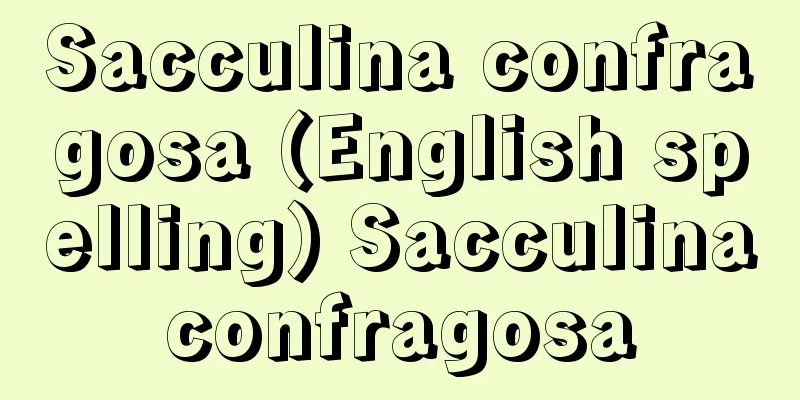Tanuma era

|
This usually refers to the period from 1767 (Meiwa 4) when Tanuma Okitsugu became a chamberlain (sobayonin), to when he gained real power in the shogunate as a senior councilor (1769) and then a senior councilor (1772), up to his downfall in 1786 (Tenmei 6). [Tadao Yamada] PoliticsThere has traditionally been a clear tendency to view politics in the Tanuma era in the second half of the 18th century as corrupt in its entirety, in contrast to politics in the Kyoho period (1716-1736) in the first half of the same century. This has seen Tanuma Okitsugu as a symbol of corrupt politics, placing him at the very top of money politics, and contrasting it with the perennial problems of corruption and dishonesty among officials, decadence of the samurai, and the breakdown of public morals at its base, as well as financial difficulties and rising prices due to the minting of bad coins, the poverty of the lives of middle and lower-class samurai and middle and lower-class urban residents, and the sacrifice of exploitation due to the shogunate's profit-making policies through collusion with commercial/usury capital. Furthermore, he described the Tenmei era (1781-89) as a time of social unrest and the rise of peasant uprisings and urban destruction, as well as natural disasters such as the eruption of Mount Asama, the Tenmei famine, and other events. He understood and recognized the Tanuma era as a time of bad government. However, many of these events were not unique to the Tenmei period when Tanuma was at his peak. For example, most of the economic policies that are generally understood to be those of Tanuma's government were not related to Tanuma Okitsugu, but rather were implemented under the leadership of the government of Matsudaira Takechika, the chief senior councilor (Kattegakari Kentai) in the 1760s and 1770s. This way of understanding that links everything to Tanuma's government is historically incorrect. However, although bribery, which many people strongly criticize, was a custom at the time, it is also true that Tanuma's government became one in which bribery was openly practiced, especially during the Tenmei period when Tanuma was at his peak, so it cannot be said that he was only badly regarded after his downfall. This power structure is because the governments of Matsudaira Takemoto and Tanuma Okitsugu were essentially based on a common power base, and Takemoto's basic policy was a continuation of the commercial policy of the Kyoho Reforms, so he was, so to speak, an outgrowth of the politics of the Kyoho period. Therefore, Tanuma's government was an extension of that. Despite this, Okinobu alone was attacked, not only because of the resentment of the Gosanke and Fudai daimyo families due to his rise to power as a shogunate retainer, but also because he had strengthened his conflict with the general shogunate retainers by consolidating the top and core members of the shogunate cabinet with Tanuma's faction, mainly those with connections to the shogunate and his family, to the point that Okinobu's monopoly on power could be said to have been achieved. Furthermore, many of the new policies that were linked to commercial capital exposed ordinary people such as peasants and townspeople to direct exploitation by commercial capital, which led to widespread public resentment. With the death of the 10th shogun, Tokugawa Ieharu in August 1786, Okinobu was ousted in one fell swoop and the highest echelons of power collapsed. The destruction of Edo in May of the following year, 1787, marked the final blow to the Tanuma era. [Tadao Yamada] Economy and SocietyIn the late 18th century, from the Horeki to Tenmei periods (1751-89), the further development of small commodity production encouraged the growth of small producer peasants, while the feudal society began to change significantly and the crisis of the feudal system deepened. The feudal lords, who had supposedly relied on the exploitation of feudal tributes based on the production of honnengu (annual taxes), found it difficult to increase the tax due to resistance from the peasants. The same was true for the shogunate, whose finances fell into the red in the latter half of the Horeki period (1751-64). Therefore, from the end of the Horeki period to the beginning of the Meiwa period, the shogunate's economic policy changed, and small commodity production, the result of peasant activities, was aggressively exploited by implementing a monopoly system. In response, the peasants fought, demanding the freedom of small commodity production and distribution, i.e., the abolition of the monopoly system. This is why it became a central item in the demands (petitions) of peasant uprisings during this period. Amid these developments, the shogunate issued repeated frugality orders from the Meiwa to Tenmei eras, as had been the case in the previous era, while also implementing a series of new economic policies. First, during the Meiwa and An'ei eras (1764-1781), the shogunate encouraged the manufacture of goods in bales for export to China (shark fins, roasted sea cucumbers, and dried abalone) in Nagasaki trade, encouraged copper mining to secure copper for Nagasaki exports, established a copper mint in Osaka (1766, Meiwa 3), and implemented a monopoly on mineral products. On the other hand, gold and silver were imported from abroad through Nagasaki, and new Nanryo 2shu silver coins were minted, as well as other coins such as 5 momme silver and brass 4-mon coins. However, as seen in the Meiwa Oil Law (1763), these policies were exploited by monopoly wholesalers who colluded with feudal power, resulting in the disadvantage of small peasant producers. The same can be said about the establishment of the Raw Silk Trade Office in 1781 (Tenmei 1), which led to widespread resistance from small peasant producers, as seen in the Joshu Silk Rebellion of the same year. The same can be said about the official recognition of numerous stock associations that were granted by the payment of taxes and contributions. The aggressive economic policies under the Tanuma administration were implemented during the Tenmei era by the financial magistrates Matsumoto Hidemochi and Akai Tadaaki. In addition to the development of new fields funded by Osaka and Edo townspeople, such as the reclamation of Inbanuma and Teganuma, and the plan to excavate the gold mines at Mount Kongo in Yamato, the development of Ezo and the direct trade plan (which could potentially develop into trade with Russia) were moves that could lead to revisions to the isolationist system, and these, combined with the aggressive moves toward trade in Nagasaki, were also noticed by the Dutch trading post chief, Teching, as rumors of an opening up of the country. Tanuma also imposed official taxes on wealthy Osaka merchants, and attempted to establish a money lending association to lend to various feudal lords by collecting money from peasants and townspeople throughout the country, but this was met with fierce opposition from the Gosanke and other feudal lords. With Tanuma's downfall, the policies were reversed. Moreover, amidst a series of disasters such as the Horeki Famine (1755, Horeki 5), the Meiwa Drought (1771, Meiwa 8), and the Great Edo Fire of the Meiwa Period (1772), which caused growing social unrest, the Tenmei era began with the Great Tenmei Famine from 1782 to 1786 (Tenmei 2 to 6), followed by frequent natural disasters such as the Great Asama Eruption (1783) early in the period and the Great Kanto Flood (1786) towards the end. Thus, peasants and townspeople, suffering from exploitation and plundering by feudal power and monopoly wholesale capital, faced successive famines and disasters, sparking peasant uprisings and seditions all over the country, and confronting the contradictions of the feudal ruling system with force. In 1784, when Wakadoshiyori Tanuma Okitomo (the eldest son of Okitsugu) was attacked with a sword, Sano Zenzaemon Masakoto, who stabbed him, was celebrated as a "Great Deity of Reform" and this was also one of the protests by the people. In 1783, the Tanuma era came to an end amid the rise of uprisings and riots across the country from 1786 to 1787. This was a period when the structural crisis of the feudal domain system was becoming increasingly serious, and it was also the beginning of the transformation or dissolution of the feudal domain system. [Tadao Yamada] Thought and CultureThis period saw the birth of many unique and influential figures in thought and culture throughout the Edo period. Very early on, political thinkers such as Takeuchi Shikibu (Horeki Incident) and Yamagata Tadayi (Meiwa Incident) pioneered anti-shogunate ideology, while social thought saw the emergence of peasant communist thinkers such as Ando Shoeki (work "Shizen Shin'ei-do"), who envisioned a natural world without exploitation, based on direct cultivation. In terms of scholarship, Ogyu Sorai's academic methods of ancient learning (Kobunjigaku) eventually extended to the study of the classics of Japanese culture, culminating in Motoori Norinaga's national learning. Furthermore, the translation of Kaitai Shinsho by Maeno Ryotaku and Sugita Genpaku led to the rise of Dutch learning, with Hiraga Gennai emerging on its fringes. Both national learning and Dutch learning can be said to be new academic fields that characterized this period. In terms of culture, the literary side of the period shows remarkable characteristics. First, Tenmei-style kyoka poems, centered around Yomono Akara (Ota Nanpo) and Karakoromo Kisshu, were popular at the time, and Yosa Buson's haiku poems swept the Tenmei haiku world (he was also good at painting literati), and Karai Senryu's senryu poems also became popular. New literary styles such as kibyoshi, sharebon, and yomihon were also born. Koikawa Harumachi was a kibyoshi author, and novelists and comedians such as Ueda Akinari and Hiraga Gennai emerged. In painting, the literati painter Ike no Taiga breathed fresh air into the art world, and Maruyama Okyo also founded the Shijo school with his sketches. Ukiyo-e, following the emergence of Suzuki Harunobu, reached its peak with Kitagawa Utamaro, who elevated it to an art form unique to Edo. In terms of culture and art, it was during this period that Edo culture began to flourish, thanks to the wealth of Edo townspeople who had finally acquired economic power, rather than remaining an intellectual pastime for samurai intellectuals (many of whom were shogunate retainers) who were highly educated in Chinese classics. The so-called 18 Great Arts gave birth to the refined Edo culture of iki (cool) and tsu (traditional style). [Tadao Yamada] "Kyoho and Kansei" by Hayashi Motoi (National History 16, 1971, Bun'eido)" ▽ "A Study of the Bakufu-Han System at a Turning Point" by Nakai Nobuhiko (Hanawa Shobo, 1971)" ▽ "Transformation of the Bakufu-Han System" by Oishi Shinzaburo (Japanese History 20, 1975, Shogakukan)" ▽ "Tanuma Period" by Tsuji Zennosuke (Iwanami Bunko)" ▽ "History of the Early Modern Japanese Nation: Tanuma Period" by Tokutomi Soho (Kodansha Academic Library)" ▽ "The Era of Tanuma Okitsugu" by Oishi Shinzaburo (Iwanami Gendai Bunko) [References] | | | | | | |Kaitai Tachibanashu| | | | | | | | | | | | | |Takeuchi | | | | | | | | | | | | | | | | |Source: Shogakukan Encyclopedia Nipponica About Encyclopedia Nipponica Information | Legend |
|
田沼意次(おきつぐ)が側用人(そばようにん)となった1767年(明和4)以降、老中格(1769)、老中(1772)となり幕閣で実権を掌握したときから、失脚した1786年(天明6)までの時期をさすことが多い。 [山田忠雄] 政治18世紀後半の田沼時代の政治について、同世紀前半の享保(きょうほう)期(1716~36)の政治と対比して、政治全体を腐敗したものとみる傾向が従来は顕著だった。それは、田沼意次を腐敗政治の象徴的存在とみ、彼を金権政治の最頂点に置いて、その裾野(すその)には役人の汚職と不正、武士の退廃、風紀の紊乱(びんらん)が展開し、財政の窮乏と悪貨の増鋳による物価騰貴と、中下級武士と都市中下層住民の生活困窮、商業=高利貸資本との癒着による幕府営利政策に伴う収奪の犠牲といった宿弊を対置する。そのうえに天明(てんめい)年間(1781~89)には浅間山噴火、天明飢饉(ききん)の天変地異、百姓一揆(いっき)、都市打毀(うちこわし)の高揚と社会不安といった構図を描き、悪政の時代として田沼時代を位置づけて把握し、認識していた。 しかしこれら諸事象の多くは田沼全盛期の天明年間固有のものではない。たとえば田沼政治の経済政策と普通理解されているものの大半は、田沼意次と関係なく、むしろ1760~70年代の老中首座(勝手掛兼帯(かってがかりけんたい))松平武元(たけちか)政権の主導下に実施されたものだった。このようにすべてを田沼政治に結び付ける理解の仕方は、歴史的に正しくない。しかし、諸人の激しく非難する賄賂(わいろ)も当時の習慣だったとはいえ、とくに田沼の全盛期である天明年間には賄賂公行の政治となったのも事実で、失脚後の悪評とばかりはいえない。このような権力構造は、松平武元―田沼意次の政権が本質的に共通の権力基盤にたっているためであり、しかも武元の基本的方針は享保の改革の商業政策を継承したものであるから、いわば享保期の政治の落とし子的性格をもつものであった。したがって田沼政治もその延長線上にあったわけである。にもかかわらず意次1人が攻撃されるのは、幕臣の成り上がりゆえの御三家(ごさんけ)・譜代(ふだい)門閥大名層の反感に限らず、意次の政権独占体制といえるほど幕閣の首脳・中枢部を、閨閥(けいばつ)・縁故者を中心に田沼派で固めたことにより、一般幕臣との対立を深めたことにあった。しかも商業資本と結合した多くの新政策が、百姓・町人ら一般民衆を商業資本の直接的な収奪にさらすことになり、広く民衆の怨嗟(えんさ)の声を浴びることになった。1786年8月、10代将軍徳川家治(いえはる)の死を契機に、一挙に意次は失脚せしめられ、政権の最高部が崩壊した。翌87年5月の江戸打毀は、田沼時代に引導を渡すものだった。 [山田忠雄] 経済・社会18世紀後半の宝暦(ほうれき)~天明期(1751~89)には、小商品生産のいっそうの発展に伴って、生産者小農民の成長が促されるとともに、幕藩制社会も大きく変質し始め、幕藩制の危機も深まりだした。たてまえとして本年貢(ほんねんぐ)生産に基づく封建貢租の搾取に依存していた封建領主権力は、農民の抵抗もあって、年貢増徴も困難になった。幕府も事情は同じで、宝暦期(1751~64)後半には幕府財政も赤字化した。そこで宝暦末~明和(めいわ)初年に幕府経済政策は転換し、農民の営為の成果である小商品生産を、専売制の実施によって強力的に搾取していく。それに対して生産者農民は小商品生産と流通=営業の自由(専売制の廃止)の要求を掲げて闘った。この時期の百姓一揆の要求(願書)の中心項目となったゆえんである。こうした動きのなかで、幕府は明和~天明期にかけて、前代に続いて繰り返し倹約令を出す一方、次々と新しい経済政策を実施した。まず明和・安永(あんえい)年間(1764~81)に長崎貿易の中国輸出の俵物(たわらもの)(鱶鰭(ふかひれ)、煎海鼠(いりこ)、干鮑(ほしあわび))製造の奨励、長崎輸出品として銅確保のための銅山の採鉱奨励、大坂における銅座の設置(1766=明和3)、鉱産品の専売制の実施が行われた。一方、長崎を通じて外国から金・銀を輸入して南鐐(なんりょう)二朱判銀を新鋳、ほかに五匁銀、真鋳(しんちゅう)四文銭など貨幣を鋳造した。しかしこれらの政策は明和の油方仕法(あぶらかたしほう)(1763)にみられるように、封建権力と結託した独占的問屋に収奪されて、生産者小農民には不利益な結果となった。同じことは1781年(天明1)の生糸改(あらため)会所の設置にも当てはまるが、かくて同年の上州絹一揆のごとく生産者小農民の広範な抵抗を生んだ。また運上・冥加(みょうが)上納で許可された数多くの株仲間の公認にも、同じことがいえる。 田沼政権下での積極的な経済政策は、勘定奉行(かんじょうぶぎょう)松本秀持(ひでもち)、赤井忠皛(ただあき)によって天明年間に実施された。大坂・江戸町人の出資による新田開発=印旛(いんば)沼・手賀(てが)沼の干拓工事、大和(やまと)金剛(こんごう)山金鉱発掘計画などのほか、蝦夷(えぞ)地開発と直営交易計画(オロシヤ交易に発展する可能性をもつ)にみられる鎖国体制を修正しかねない動きは、長崎貿易への積極的な動きと相まって、オランダ商館長ティチングも開国の噂(うわさ)として着目している。また大坂の富商に御用金を課し、さらに全国の百姓・町人などからも金を取り立てて諸大名へ金融する貸金会所設立をもくろみ、御三家・諸大名の激しい反対にあった。田沼失脚とともに諸政策は撤回された。 しかも宝暦飢饉(1755=宝暦5)、明和の干魃(かんばつ)(1771=明和8)、明和の江戸大火(1772)と災害が相次いで社会不安の高まるなかで、天明年間に入ると、1782~86年(天明2~6)にかけて天明の大飢饉にみまわれ、その初期に浅間山大噴火(1783)、末期に関東大洪水(1786)と天変地異が頻発した。かくて、封建権力と独占的問屋資本の搾取・収奪にあえぐ百姓・町人は連年の飢饉・災害に遭遇して、全国各地で百姓一揆・打毀を激発させて、封建支配体制の矛盾に実力で対決した。1784年、若年寄田沼意知(おきとも)(意次長男)の刃傷(にんじょう)事件のとき、彼を切りつけた佐野善左衛門政言(まさこと)が「世直し大明神」ともてはやされたのも、民衆の抵抗の一つだった。1783年、1786~87年に全国的に一揆・打毀の高揚する最中、田沼時代の幕は閉ざされた。この時期は幕藩制にとって体制的危機が構造的に深刻化していったが、幕藩制の転換ないし解体の起点ともなった時期でもあった。 [山田忠雄] 思想・文化この時期は、江戸時代を通じて思想・文化の面でも著しく特色のある独自性をもち、かつ後世への影響を及ぼすものが生まれている。ごく早期に、政治思想のうえで竹内式部(しきぶ)(宝暦事件)、山県大弐(やまがただいに)(明和事件)のような反幕思想の先駆を生み、また社会思想の面では直耕(ちょくこう)=搾取のない自然世を構想する安藤昌益(しょうえき)(著作『自然真営道』)のような農民的共産主義思想家が登場した。 学問のうえでも、荻生徂徠(おぎゅうそらい)の古学(古文辞学(こぶんじがく))の学問的方法はやがて日本文化の古典研究に及び、本居宣長(もとおりのりなが)の国学として大成する。また前野良沢(りょうたく)、杉田玄白(げんぱく)らの『解体新書』の訳業が端緒となって蘭学(らんがく)が勃興(ぼっこう)し、その周縁に平賀源内(ひらがげんない)も出た。国学・蘭学ともに、この時期を特色づける新しい学問といえよう。 文化では文芸面に著しい時代的特色がみられる。まず四方赤良(よものあから)(大田南畝(なんぽ))、唐衣橘洲(からころもきっしゅう)を中心とする天明調狂歌が時好に投じ、また与謝蕪村(よさぶそん)の俳諧(はいかい)は天明俳壇を風靡(ふうび)し(彼はまた文人画もよくした)、柄井川柳(からいせんりゅう)の川柳も流行した。黄表紙(きびょうし)、洒落本(しゃれぼん)、読本(よみほん)など新しい文芸様式も生まれている。黄表紙作者として恋川春町(こいかわはるまち)がいるが、小説、戯作(げさく)者として上田秋成(あきなり)、平賀源内らが輩出した。絵画では文人画の池大雅(いけのたいが)が画壇に新風を吹き込み、また円山応挙(まるやまおうきょ)も写生をもって四条派をおこした。浮世絵は鈴木春信(はるのぶ)が出て以来、喜多川歌麿(きたがわうたまろ)に至って最高潮に達し、江戸独自の芸術に高めた。文化芸術面では、漢学的教養の高い武士知識人(幕臣が多い)の知的遊戯にとどまらず、ようやく経済的実力を身につけてきた江戸の町人たちの豪富によって、江戸文化として盛行し始めるのもこの時期である。いわゆる十八大通を中心に粋(いき)とか通という洗練された江戸の文化を生んだ。 [山田忠雄] 『林基著『享保と寛政』(『国民の歴史16』1971・文英堂)』▽『中井信彦著『転換期幕藩制の研究』(1971・塙書房)』▽『大石慎三郎著『幕藩制の転換』(『日本の歴史20』1975・小学館)』▽『辻善之助著『田沼時代』(岩波文庫)』▽『徳富蘇峰著『近世日本国民史 田沼時代』(講談社学術文庫)』▽『大石慎三郎著『田沼意次の時代』(岩波現代文庫)』 [参照項目] | | | | | | | | | | | | | | | | | | | | | | | | | | | | | | | | | | | | | | |出典 小学館 日本大百科全書(ニッポニカ)日本大百科全書(ニッポニカ)について 情報 | 凡例 |
<<: Tanuma noisy animals - Tanuma noisy animals
Recommend
Xenogryllus marmoratus (pine cricket)
A medium-sized light brown cricket (illustration)....
Branislav Nusić
A playwright and novelist from the Kingdom of Yug...
Crime and Punishment - Crime and Punishment
A book on criminal law written in 1764 by the Ital...
MIAI - Miai
The abbreviation for Majlis Islamil A'laa Indo...
Kyoto Prefecture - Kyoto
A prefecture in the central-northern part of the K...
jack-o'-lantern
…Today, it is famous as a children's festival...
Shellfish poisoning
This phenomenon occurs when bivalve shellfish, mai...
Churchill
British politician. In his youth, he suppressed th...
Masamu Yanase
Born: January 12, 1900, Matsuyama Died: May 25, 19...
Mortarboard - Kakubo
A cap worn by university students, with a flat, s...
Emberizidae
...In winter they are often seen in small flocks,...
Hull, Cordell
Born October 2, 1871 in Overton, Tennessee Died Ju...
Senegambia
...This incident prompted an agreement to be sign...
Gracchi Brothers - Gracchi Brothers
Two brothers who were reformist politicians from ...
Wise, TJ
…To give it authority, the origin and history of ...









